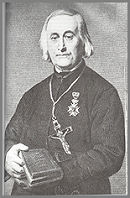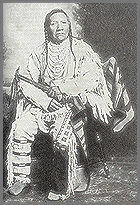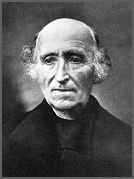
 | ||||||
One of his recruits was a true renaissance man, Father Anthony Ravalli, S.J. an Italian, who arrived at St Mary's in November 1845. In addition to being a Jesuit priest, he was Montana's first physician, surgeon and pharmacist. He was an architect, an artist and sculptor. He built the first grist mill and saw mill. Religion classes were held twice a day. There were classes in reading, writing and arithmetic taught in the Salish language. There was a band which played numbers by German and Italian composers. The Indians were taught to plow, plant, cultivate, irrigate and harvest crops and to tend cattle, sheep, pigs and poultry.
A larger church was under construction in 1846. Before it's completion, problems with the Salish's traditional enemies, the Blackfoot, forced what was intended to be a temporary closure of the Mission. By terms of a Conditional Bill of Sale in November 1850, John Owen, a former army sutler, bought the improvements for $250.00. Should the Jesuits return within two years the mills and fields would revert to them. When they were unable to return by the designated time, the Jesuits sent word to burn the church to save it from desecration. The former mission site became Fort Owen, a trading post.
It was sixteen years later (1866) when Father Joseph Giorda, Superior for the Rocky Mountain area, called back Father Ravalli and Brother William Claessens and re-established St. Mary's Mission about a mile south of Fort Owen. Brother Claessens built a little chapel, the fourth he had built for St. Mary's, to which he attached a study, dining room, kitchen and a story and a half barn. Father Giorda made the "new" St. Mary's the Jesuit mission headquarters for the Rocky Mountain province. In 1879 an addition to the front of the building doubled the size of the chapel. The entire Mission complex has been restored to that date - the peak of its beauty.
Today Old St. Mary's stands as a monument to those heroic sons of the mountains, through whose efforts the first trail into Montana was blazed with the Cross, and to those dedicated Jesuits who were the pioneers of Montana's pioneers.
The mission complex includes the chapel/residence, Father Ravalli's log house/pharmacy, Chief Victor's cabin (now a Native American museum), DeSmet park with picnic facilities, the cemetery where Father Ravalli is buried and the Native American burial plot. A Visitor's Center was added in 1996 and houses a gift shop as well as a research library, art gallery and museum which houses some of Father Ravalli's hand tools and farm equipment as well as historical documents and photographs.
Learn More About Historic St. Mary's Mission
Fr. Pierre DeSmet, S.J.
Courtesy Gonzaga University
Charlo
Head Chief of the Flatheads
Courtesy Mt. Historical Society
Fr. Antonio Ravalli, S. J.
A tour of Historic St. Mary's Mission is a visit to the cradle of civilization in Montana - a truly enlightening and historical experience.
The history of St. Mary's Mission begins with the arrival in the Northwest of twenty-four Iroquois Indians employed as trappers by the Hudson's Bay Company. During the 1823-24 season, twelve of these Iroquois remained among the Salish in the Red Willow (now Bitterroot) valley. They were adopted into the tribe and married the Salish women.
Coming from a nation which had been introduced to Christianity some two hundred years earlier, when they gathered around the campfire in the evenings the Iroquois talked about white men who wore long black gowns, carried crucifixes, did not marry and whose practice it was to instruct people, bringing them to know God and all things to enable them to live after death. The Salish, together with their neighbors the Nez Perce, became so interested in these stories that between 1831 and 1839 they sent four delegations to St. Louis to obtain a Black Robe to live among them to teach them all these things to which the Iroquois referred.
On September 24, 1841, Father Pierre Jean DeSmet, together with his fellow Jesuit missionaries, Fathers Gregory Mengarini and Nicolas Point, and three Lay Brothers arrived in the Bitterroot valley with their belongings and supplies in three carts and a wagon, the first vehicles to enter the area. They established the first white settlement in what was to become Montana, on the east bank of the Bitterroot river, immediately west of the present town of Stevensville. The new mission, as well as the river and the tallest mountain peak to the west, were named "St. Mary's". Fifty years later the name of the river was changed to "Bitterroot" by the Forest Service.
The first chapel measured 25x33, with two galleries in order to accommodate the entire tribe. Father DeSmet made a trip to Fort Colville of the Hudson Bay Company and returned with supplies to tide them over the winter, plus wheat, oats, potatoes and garden seeds for the first crops.
The news of the Black Robes' arrival spread, and within a short time Indians from many tribes came to visit. The following year, a larger church, 30x60, was built a few hundred yards east of the river. Following a trip to Fort Vancouver on the west coast, from where he brought into Montana the first cattle, swine and poultry, Father DeSmet returned to St. Louis. After seeing off a group of helpers to travel overland to St. Mary's, he left for Europe to seek recruits and funds for the new mission area in the Northwest.
406-777-5734
Email: stmary@cybernet1.com
www.saintmarysmission.org

Last Update: 8/24/2016
Historic St. Mary's Mission, Inc. * All Rights Reserved
Web Site Design by S&J Enterprises
P.O. Box 211
315 Charlo Street
Stevensville, MT 59870





